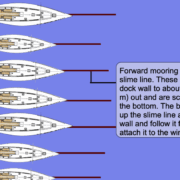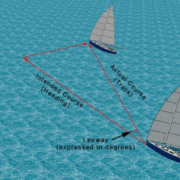How Raise or Unfurl Sails
If you’re hoping to learn how to sail, at some point, you’ll need to raise (i.e., “hoist”) or unfurl your sails. First things first. When someone says “unfurl”, they mean to unroll and open up your sails (and there are a few ways that this can happen). When someone says that a sail needs to be “raised” or “hoisted” – this means that it has been stored (“stowed”) without being rolled, but it needs to be “raised” up the mast rather than “unrolled” or “unfurled”. Whether you’re going to be unfurling or raising depends entirely on how your boat stores its sails.
How mainsails can be stored:
- Lowered and lashed onto the boom
- Lowered into a stack pack (a long bag permanently mounted above the boom)
- Rolled into the mast (mast-furled mainsail)
- Rolled onto the boom (boom-furled mainsail)
- Removed and folded into a sail bag for stowage below
One of the fun things about sailing (or teaching about sailing) is that everyone has an opinion about the “best” way to do something. It makes for fun debate! What we’ve found is that while there are certainly wrong ways to do things like raise/unfurl a sail (ways that are unsafe for the sailors or the boat), there can also be multiple right ways. Everyone has their own preferences, often relating to the specific boat they are sailing — we sure do!
And speaking of teaching, portions of this post come out of Module 5 of our Introduction to Sailing NauticEd course. If you’d like to learn how to sail, we highly recommend starting with a course like this so you can get used to the sailing terminology and learn some basics.
As you get more comfortable with sailing, you’ll find that you’ll develop your own process, especially for the tasks you do every time you sail (like raising or unfurling the sails). A process that stays the same each time is an excellent recipe for success, especially if you need to move quickly. Here are the ways that we start teaching beginners how to raise/unfurl the sails.
How to raise or unfurl the mainsail (the basics)
- Prepare: loosen the mainsheet, boomvang, cunningham, and reefing lines (if taut)
- Steer into the wind and stay directly in the wind (you might need to keep a little engine speed to maintain steerage)
- Raise (hoist) or unfurl the mainsail (we go through the most common ways to do this in Intro to Sailing)
- Cleat off the halyard and tighten down on the cunningham
- Tighten the mainsheet appropriately
- Bear away from the wind and get the boat sailing
- Turn off the engine
Tip:
The amount of tension in the leading edge (luff) through the halyard or cunningham relates to wind strength. Light winds? Slight tension so that the sail stays baggy and has lots of shape. High winds? High tension so the sail is less curved.
How to unfurl the headsail
- Have the downwind jib already wrapped 2-3 turns around its winch (you can’t hold it by hand if the wind is strong).
- Check the jib furling line and make sure it’s laid out and won’t tangle when it flows out.
- Pull (haul) on the downwind jib sheet and the headsail will unfurl and start filling with wind.
- Ideally, keep light tension on the jib furling line to keep it from jamming or overlapping in the drum.
- Control how quickly it unfurls by wrapping the jib furling line around a winch or cleat to slow it down.
Pitfalls:
- If the furling lines are allowed to unfurl as quickly as they want to (you’re not controlling them), you can create bird’s nest in the furling drum. Just to make sure, check the furling drum after the jib is up.
- Look aloft! Chase every line its full length with your eyes as you winch in. If it’s tangled, whoever is cranking the winch is just pulling against the furling system.
How to raise the headsail
- If you don’t have a roller-furling headsail, you’ll need to prep a little before you head out of the marina. This is how we raise the headsail:
- Select the appropriate size headsail (high winds = smaller sail needed): #1 is the largest (the genoa), #2 is for midrange, #3 is the smallest for high winds.
- Prepare the headsail for deployment before leaving the marina:– Lay the headsail out on the foredeck.
– Attach the headsail halyard to the head (the top connection point) of the headsail
– Attach the tack of the headsail to a clip mounted at the base of the forestay
– Attach the clew of the headsail to the jib sheets (we recommend using the bowline knot)
– Run the jib sheets back through the appropriate fairleads that will guide the jib sheets back to the cockpit.
– Clip the hanks (small clips permanently attached every 2-3 feet around the bolt rope of the leading/luff edge of a headsail) onto the forestay.
– Use sail ties or bungies to secure the sail down to the foredeck. Alternatively, many sailors permanently attach shock cord to the toe rails to quickly secure the headsail to the foredeck.
- When your mainsail is up and you’re sailing, untie the sail ties as another crew member pulls on the headsail halyard.
- Move back to the cockpit (flapping headsail and jib sheets can be dangerous)
- Trim the leeward headsail sheet with the headsail sheet winch.
You’ll notice that we didn’t go into detail about the mainsail because it is so dependent on how the mainsail is stored and requires a little more space than a blog post. In the Intro to Sailing online sailing course, we talk about these different ways to unfurl or raise a mainsail and then also have some handy interactive graphics for all of us visual learners. This really is a great place to start, especially if you’d like to go sailing as a crew member and want to feel like you know the language and some basic sailing principles. In other words, you can impress your skipper!









